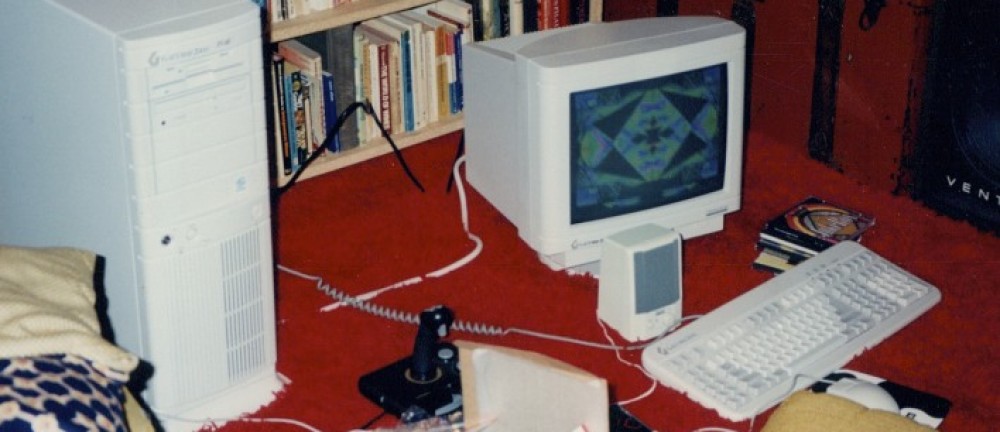I’ve been thinking about the consumer video market a lot recently. I figured I’d take some time to sum up my thoughts about where we’re at and where we’re going.
First off, lets just all agree that for consumers, tape is dead. While HDV and DV will hang around for a while, coughing up blood, consumers should never again see a linear format for video. The optical formats (mini-DVD) may hang around for a bit, but they too should die off before too long.
Why? Because I think most folks who have shot home movies agree that the linear nature of tape is a huge disincentive to repeat viewing. Because tapes give you 60 minutes of continuous video, you’re inclined to shoot far more than makes sense, which makes it that much less fun to go back and find the good parts. Similarly, bringing it into a computer is too hard and takes too long to make it worthwhile for most consumers.
The DVD formats are a bit better than tape, but come with their own negatives in terms of form factor and robustness.
That brings us to solid state. Most cell phone video is truly terrible right now, but another few months and we’ll start seeing more VGA-quality recording. For a lot of people, it’ll be good enough to capture Jimmy blowing out the candles on his birthday cake, etc, just like for many folks, the stills produced by a cell phone camera are “good enough” for day-to-day events.
The next step up from cell phones is still cameras with video capabilities. These vary widely right now – some cameras don’t do video at all, some do video with no audio, and some do proper all singing, all dancing video. The Casio Exilim line, with its “youtube mode” is a good example. Quality takes a step up for a cell phone, but the form factor is oriented towards stills (obviously) and audio, if present at all, is bound to be subpar.

Moving beyond still cameras (incidentally, the Exilim retails for well under $250) you get into a murky world of old-line camcorder manufacturers and new companies you’ve never heard of.
To start out with, you’ve got the Pure Digital Flip Video Ultra. For under $200, you get a camera that will record between 30 and 60 minutes of video (depending on the model) with a not-all-that-horrible microphone, 640×480 30fps video and a rather neat built in USB plug. Aimed squarely at YouTube users, the Flip may be a good choice to give to the kids for recording their hijinks, but the lack of a still-frame mode means you’re going to be carrying the Flip in addition to your digital still camera. Who wants that?

If you’re looking for a decent still camera with good video capabilities and a nice form factor, you really need to investigate the Sanyo Xacti line. Whether you’d like a waterproof SD camera, or a full 1080i monster, they’ve got you covered. The Xacti line differentiates itself by providing a proper lens, and on many models, a microphone input. That’s a feature that really sets the Xacti line apart for folks who want to do slightly more professional recordings. Quality isn’t quite at the level of an HDV camera, but it’s not bad either. If I had to spend my own money, I’d probably get their HD2, which shoots 720p video and 7.1 megapixel stills. I love the form factor – it feels great in your hand, and the “one button for video, one button for stills” layout makes it incredibly easy to use.
Downsides? The video isn’t optically stabilized. The digital stabilizer is slightly better than absolute crap. No problem on wide shots, but doing a 10x zoom handheld is going to be pretty jumpy, especially after that second cup of coffee.
Expect to pay around $350 for the lesser Xacti models, on up through $600 for the HD2 and $800 for the HD1000.

Sanyo HD1000 1080i model
From there, things start to get really serious, as we start to find the old guard of camcorder makers. Sony enters with a variety of Memory Stick and HardDrive based models. I’m not a fan of harddisk recorders – you’ve got moving parts, you’re limited to the built in capacity and battery life takes a hit. The HDR-CX7 meets all the right criteria though – direct to memory stick recording, AVCHD recording, and all the features you’d expect on a consumer camcorder (no mic in though!). 6.1 megapixel stills round out the feature set, and you can find it for around $900.
That said, the real bargain in this space is the Panasonic HDC-SD5. You get 3 1920×1080 imagers, optical image stabilization, and direct-to-SD card recording. The fact that it’s 3CCD really sets this model apart. It records in the same AVC-HD as the Sony, so you can expect compression quality that is only slightly inferior to similar HDV cameras like the Canon HV20. The Panasonic will run you a bit under $900.
Downsides? Form factor. You won’t slip either the Panasonic or the Sony into your pocket. You’ll look like more a tourist with your fancy camcorder. It’s not huge by any means, but it can’t be an after-thought in packing either. For me, the lack of proper audio inputs is a disappointment as well. I think that the higher-end consumer cameras really need to get features like audio inputs if they want to differentiate themselves in the minds of savvy consumers.

So that’s where we’re at right now. Most of these cameras include basic editing software in the box, but keep in mind that iMovie ’08 should manage and edit the video produced by any of these models. Nifty!








